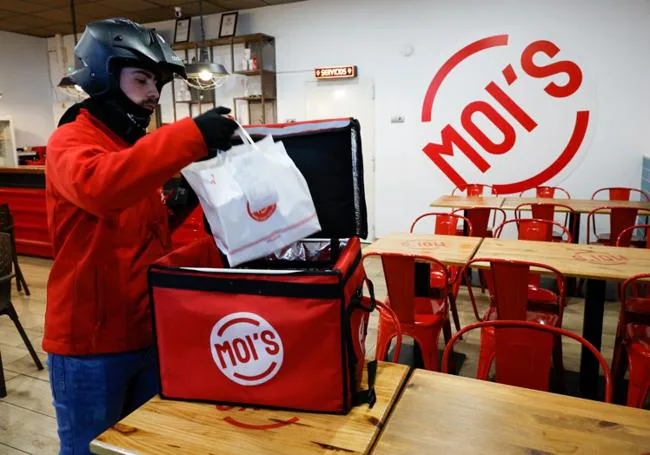What (and who) are you really paying when you order a food delivery?
Takeaway couriers. Most restaurants increase their prices to make up for the up to 30 per cent cut taken by food delivery apps such as Just Eat, Glovo and Uber Eats
Iván Gelibter
Malaga
Viernes, 26 de mayo 2023
This is going to seem ridiculous, but it really happened. A group of youngsters are chatting in the grounds of a block of flats on the outskirts of Malaga. It is 9.30pm on a Saturday. In other words, supper time.
After discussing what they fancy eating, they decide on McDonalds. But they do not move from where they are. A few minutes later, a motorbike pulls up at the gate of the building. The rider has the distinctive yellow cube-shaped Glovo branded backpack from which he takes out several brown bags from the burger chain, and hands them over the wall of the flats. Only 20 minutes have passed since they opened the app on their phone and now they have hot food in their hands. They could have walked 200 metres to the restaurant, but they decided that splitting the four-euro delivery fee was not expensive. But have they really only paid extra for delivery?
The short answer: No. When you order a delivery you are not only paying extra for delivery, but you are also spending at least ten per cent more for each product than you would if you ate in the restaurant or collected it yourself. Glovo, Just Eat and Uber Eats are the biggest food delivery apps in Spain. Although each company has different strategies, they all have something in common: taking a cut of the restaurant bill of between 15 and 30 per cent. This is the main reason why many restaurants up their prices, so that those apps don't take all of their profit. They are forced to use these platforms to stay in the market.
It is easy to prove this. Take for example a hamburger restaurant in a popular Malaga neighbourhood, that asked to remain anonymous. A burger is four euros, a portion of 'Turkish' fries (with kebab meat and yoghurt) is another four. A drink is two euros. If a customer rings up and collects the food themselves it comes to 10 euros, but if they order through an app like Glovo it can come to 14.50 euros. How is it that it costs almost 50 per cent more?

Glovo on average takes 30 per cent from the restaurants. SUR has verified with several restaurants that restaurants usually put the menu up by 15 per cent. As well as this extra euro and a half (with the example of a ten euro bill), you have to pay three more for delivery, an amount that changes depending on the delivery distance.
Now the price is 14.50 euros. From this, 8.05 euros goes to the restaurant, 3.45 to Glovo, and 3 to the driver. Sources told SUR that some apps give a portion of the total bill to the driver, but we are talking percentages of around one per cent.
How the apps work
One of the main reasons behind the success of these apps is their practicality, but this is not the only reason. When you order with Just Eat or Uber Eats, the order arrives at a specific machine in the restaurant and is automatically put into a queue, often in front of people already waiting. In other words, if you arrive at a restaurant and see 10 people in the queue, you know there are 10 orders before yours. However if an order from Glovo arrives, it skips the queue.
SUR investigated the way these applications work and the impact. It called a known local noodle chain which has its own delivery drivers, but also works with the popular apps. According to the person on the phone, the waiting time for delivery, (the restaurant was seven minutes away), was an hour and 20 minutes "at least". Then, going onto Glovo instead and making the exact same order, the driver arrived in just 38 minutes.
In a popular roast chicken takeaway in the La Paz area of Malaga something similar happens. Until recently there were two queues; one for those who had ordered by phone and another for those who had not pre-ordered. Now, a third queue has been introduced for riders, which goes much quicker than the others. In reply to the complaints of various customers, an employee admitted that: "If you order by app it will arrive much quicker than if you call". So, why do local restaurants prioritise orders from apps that take 30 per cent of their business over other orders?
Moisés López, the owner of successful burger joint Moi's in north Malaga and the tax advisor for several small businesses across Malaga, has the answer to this question, "Glovo orders arrive more quickly, that's true. This is because of Glovo's rules; they give you a maximum of 20 minutes for preparation and distribution," he explained, admitting that he, however, does not do things that way.
"I have my own drivers as well. When a Glovo order arrives I don't delay it, but I also don't prioritise it over other preexisting orders."

The case of Moisés López is particularly striking. His business opened during the pandemic and was initially just him or one of his friends delivering the orders. However, the popularity of his burgers has led to him having up to four of his own delivery drivers on the weekends. "When I see that I'm overloaded I turn off the Glovo and Just Eat machines and have just mine, meaning I don't have to share my profit with anyone." On a normal evening at the weekend his drivers deliver around 45 orders, while through the apps they can only sign up for less than ten deliveries each.
Although food delivery was already on the rise in March 2020, lockdown, restrictions and the fear of catching Covid increased demand for restaurants to bring food to the customer, despite the Spanish habit of normally always going out to eat restaurant food. Although the numbers have dropped compared to peak Covid times, this business model is not going to disappear anytime soon.
Nevertheless, food deliveries are not good business for everyone. Many restaurants are now forced to use these apps to stay in business. "It is a long time since people would call up to buy two burgers, come down to the restaurant and collect them. Now they order through Glovo even though it works out more expensive. It would be great to not have to share my profit with these apps, but if I don't work with them I will disappear from the market because a large proportion of customers will just order somewhere else," explained the owner of one restaurant in Torremolinos.
Lack of awareness
"Sometimes people do not care about the quality. They prefer to order with Glovo than to go out to eat down the road," Moisés López sighed, adding that "people do not realise they are paying more through these apps; I have told regular customers so they know, but some are still unaware".
Moisés confirmed that virtually all restaurant businesses increase food prices on the apps so as not to lose more money, going against the terms of the contract with the delivery app, which generally stipulates restaurants have to keep prices the same. "Almost no one does this and they start to do what they want," he added.
There are differences between the apps, however. "For Just Eat, to change the price you have to send them an email with a photo of the menu, but people doctor it. With Glovo you can change it yourself and it is more straightforward. But at the end of the day they all turn a blind eye, as the more expensive the order is, the more they make."
In Moises' case, he took a risk and now has four delivery drivers. However, when is it affordable to have your own drivers? "You have to have a consistent number of orders, or wait until they arrive. At least 10 or 12 daily orders to be worth it. But to get as far as that... well, you know, that is a risk that the big delivery apps don't need to take," he concluded.



